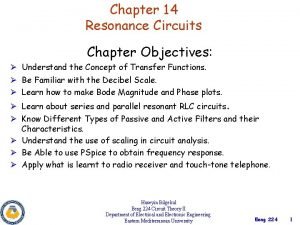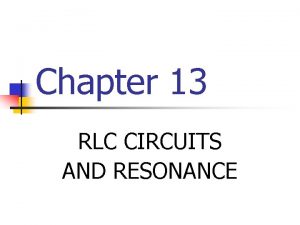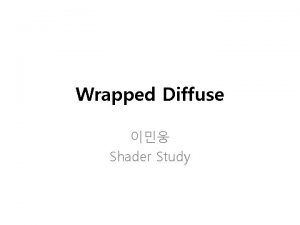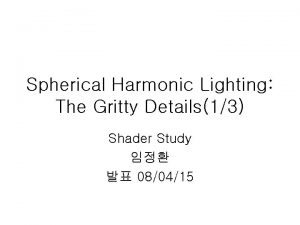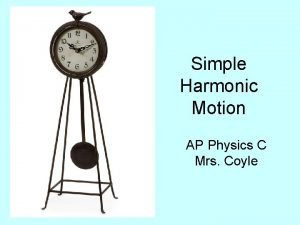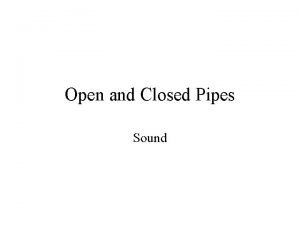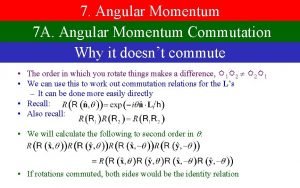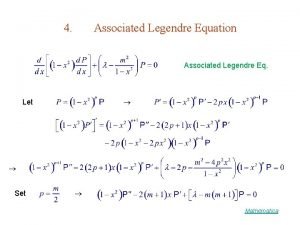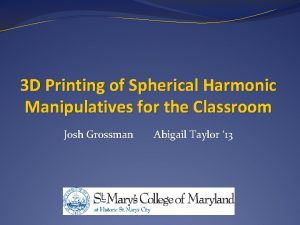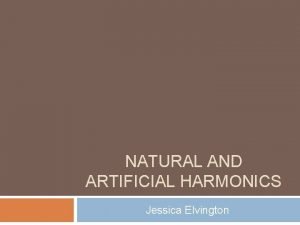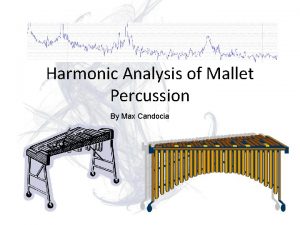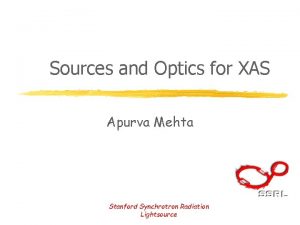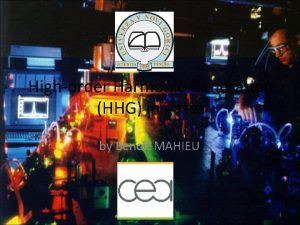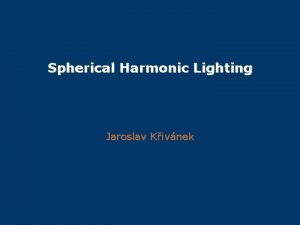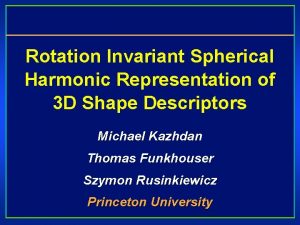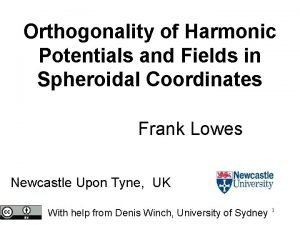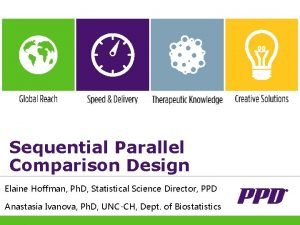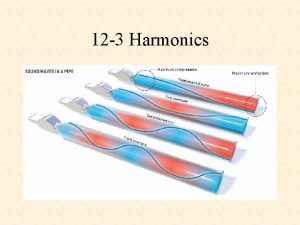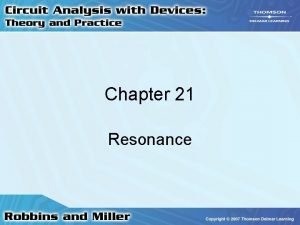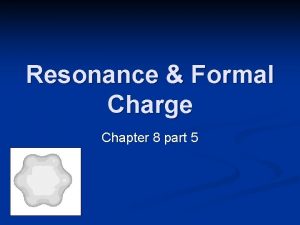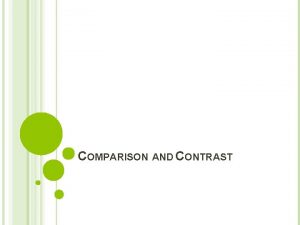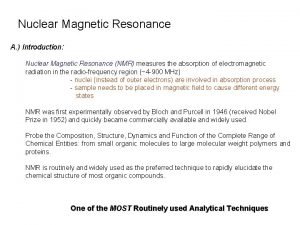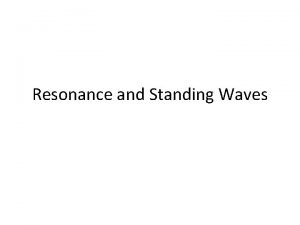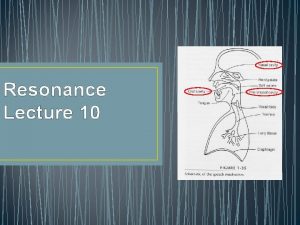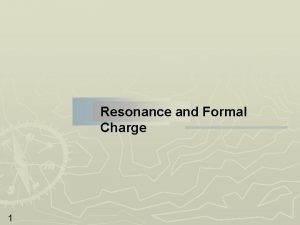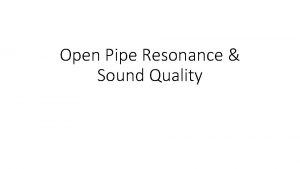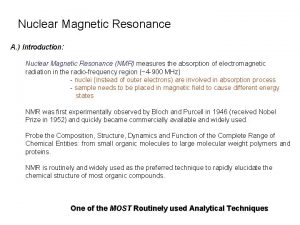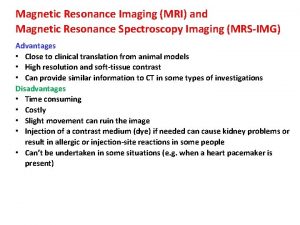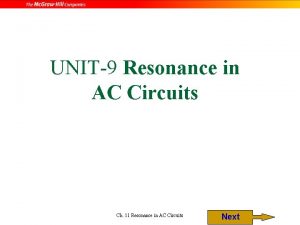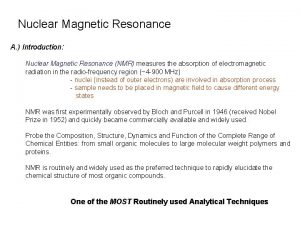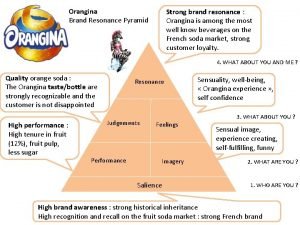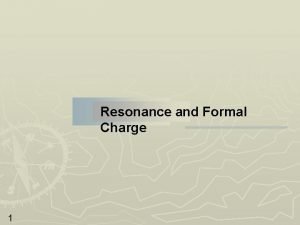Chapter 12 Parallel LC Harmonics Parallel Resonance Comparison





















- Slides: 21

Chapter 12: Parallel LC & Harmonics

Parallel Resonance: Comparison Parameter Series Parallel Z at Resonance Lowest Highest I at Resonance Highest Lowest Effect below resonance Capacitive Inductive Effect above resonance Inductive Capacitive • Notice the trend …? • Lets investigate the trend for parallel resonant circuits 2

Parallel Resonance: Characteristics • At resonance: – Inductive and capacitive reactance are equal and effectively cancel each other • Result is purely resistive character – Impedance equals resistance – Current is at its lowest 3

Parallel Resonance: Vector Analysis • See figure 12 -2 • Recall: – Z = Impedance 4

Parallel Resonance: Formula • Same equation as for series resonance! – fr = Resonant frequency – L = Inductance – C = Capacitance 5

Formula: Worked Example • What is the resonant frequency of the circuit above? – (2π*sqrt(10 e-6 x 100 e-3))-1 ≈ 160 Hz • At a frequency of 160 Hz in the above circuit, what relative current would you expect? – Minimum current since the circuit is at resonance 6

Parallel Resonance: Circulating Current • As current flows initially, electrical potential is stored in the capacitor and magnetic potential is stored in the inductor • As the current drops, the inductor acts to resist the change in current, allowing the magnetic field to collapse, causing charge to develop on capacitor • Without any losses (ie. Ideal components) the circulating current would continue resonating indefinitely 7

Preview: Oscillators • Imagine water sloshing around between two tanks which are connected by a large pipe • Voltage stored in a capacitor and magnetic potential stored in an inductor behave in an analogous manner • With minimal input, a rhythmic flip/flop of energy can occur with the resulting flow of energy producing a sinusoidal wave 8

Harmonics: Introduction • Fundamental frequency is (generally) the lowest frequency in a related grouping – One may define a frequency instead • Harmonics are integer multiples of the fundamental frequency – Eg: Frequencies as follows: • 30 k. Hz Third (odd) harmonic of the fundamental • 20 k. Hz Second (even) harmonic of the fundamental • 10 k. Hz Fundamental harmonic frequency 9

Harmonics: Waveform addition 1. 5 1 0. 5 Sin(x/4) 0 Sin(x/2)/2 A+B -0. 5 -1 -1. 5 10

Harmonics: Square Waves • Square waves may be synthesized by adding a large number of odd harmonics to achieve a relatively “flat” crest • In practice, this is achieved by analog function generators cascading mixing and multiplication stages 11

Harmonics: Speech & Music • The human voice differs between individuals primarily as a result of differences in harmonic content • Musical instruments all exploit harmonics – Simplest examples are string instruments such as the piano which have a fundamental frequency of 256 Hz for “middle C” – Richness of music is the interaction of multiple harmonics which are mathematically related 12

Frequency Spectra: From Sound to Light • Two types of transmission – Electromagnetic waves – Sound pressure (compression & rarefaction) • Major frequency spectra – Sound – Radio – Light 13

Frequency Spectra: Sound • Average human hearing extends from 20 Hz to 20 k. Hz • The majority of human voice exists between 300 Hz and 3 k. Hz – The bandwidth is therefore 3000 -300 = 2. 7 k. Hz – Telephone and SSB radio take advantage of this fact • Sound intensity (volume) measured as decibels (d. B) 14

Frequency Spectra: Sound • Decibels expresses a ratio between the threshold of hearing at 1 k. Hz and the frequency of interest • We can only hear a difference in sound volume of 3 d. B – Double the intensity since 3 d. B = 2 x 15

Frequency Spectra: Sound Pressure Source SPL (d. B) Threshold of hearing 0 Rustling Leaves 10 -20 Very Calm Room 20 -30 Conversation at 1 m 40 -60 (at 1 k. Hz) *perfect silence is -17 d. B 50 City of Ottawa Bylaw for Noise Complaints as measured in your residence Average factory 70 EPA-identified maximum to protect against hearing loss and other disruptive effects from noise, such as sleep disturbance, stress, learning detriment, etc. Hearing Damage 85 Damage to hearing (need not be continuous) Traffic on a busy road 90 Vuvuzela at 1 m 120 Threshold of pain 130 Explosive shock-wave >194 Also, jet engine at 100 m The theoretical limit for SPL 16

Frequency Spectra: Radio • Now lets take a look at the other form of frequency production: electromagnetic • Unlike sound, we can only perceive a very small range of EM frequencies – Light – Infrared 17

E. M. Frequencies: Primer • All electromagnetic frequencies between 3 Hz and 300 GHz are considered to be in the radio spectrum – That is a substantial range, from 100 to 1009 or put another way, from 1 to 100 billion • To convert between frequency and wavelength: C = speed of light, 3 x 10 (ms ) λ=c λ = wavelength (meters) f = frequency (Hz, or s ) f 8 -1 -1 18

E. M. Frequency Spectra: Bands Frequency Wavelength (m) Abrv. Common Radio “Bands” & Examples 3 Hz – 30 Hz 105 – 104 km ELF Military Submarine Radio 30 Hz – 300 Hz 104 – 103 km SLF Submarine Radio 300 Hz – 3000 Hz 103 – 102 km ULF Used in mines 3 k. Hz – 30 k. Hz 100 -10 km VLF Near-surface submarine 30 k. Hz – 300 k. Hz 10 -1 km LF Standard Time Broadcast & Subs 300 k. Hz – 3 MHz 1 km-100 m MF 180 m & AM radio 3 MHz – 30 MHz 100 m-10 m HF 80, 40, 30, 20, 17, 15, 12, (CB), 10 m 30 MHz – 300 MHz 10 m-1 m VHF 6, 2, 1. 25 m & FM radio & Air-band 300 MHz – 3 GHz 1 m-10 cm UHF 70 cm, (FRS, GMRS) 3 GHz – 30 GHz 10 cm-1 cm SHF Wi. Fi, modern Radar 30 GHz – 300 GHz 1 cm-1 mm EHF Radio astronomy 19

E. M. Frequency Spectra: Light & Beyond 20

Questions? 21
 Parallel resonance
Parallel resonance Quality factor formula in rlc circuit
Quality factor formula in rlc circuit Et 242
Et 242 Half lambert shading
Half lambert shading Closed pipe harmonics
Closed pipe harmonics Precomputed radiance transfer
Precomputed radiance transfer Simple harmonic motion formula
Simple harmonic motion formula Instruments
Instruments Harmonics formula
Harmonics formula Commutator angular momentum
Commutator angular momentum Central force
Central force Spherical harmonics formula
Spherical harmonics formula Violin natural harmonics
Violin natural harmonics K factor harmonics
K factor harmonics Dr candocia
Dr candocia Harmonics measurement
Harmonics measurement Harmonics measurement
Harmonics measurement Spherical harmonic lighting
Spherical harmonic lighting Spherical harmonics rotation invariant
Spherical harmonics rotation invariant Spherical harmonics orthogonality
Spherical harmonics orthogonality Limit comparision test
Limit comparision test Sequential parallel comparison design
Sequential parallel comparison design
